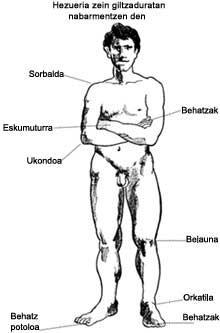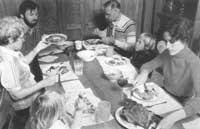Drop
1992/09/01 Agirre, Jabier - Medikua eta OEEko kidea Iturria: Elhuyar aldizkaria
Gout is a disease caused by precipitation of uric acid (in the form of crystallized salt) in a joint, although precipitation is also possible in other parts of the body (tendons, ears, etc. ). The deposit of urates in the joints produces pain and inflammation, evolving to the crisis or accésut.
Gout is a disease known since ancient times. Apparently, 944 years before Jesus Christ the king of Judea, Asa, suffered the skeleton, although the Bible did not give much light. The first well-documented case is that of Hieron, governor of Syracuse, a. C. Year 478.
XIII. Until the 20th century the drop was known as “podagra”, since the thumb of the foot was the most affected part.
Epidemiology of the disease
- Frequency:3-5 cases per 1,000 inhabitants.
- Gender: Men almost always (about 95%). Women after menopause.
- Heritage: It affects relatives in 25% of cases.
- Age: It has been observed from 16 to 70 years (at 30-60 in most cases).
- Description: It is possible in all, but especially in obese (67%).
- Race: It has been observed in all, but to a lesser extent in the Arabs (by alcoholic abstinence? ).
- Social level: It has always been related to the high social levels and the rich, but today you can see that all social classes are being hooked.
Reasons

The main protagonist is uric acid. Uric acid is the fruit of the oxidation of substances known as purines. And these purines do not come only from food (external contribution). They are also a consequence of the metabolisms of the nucleic acids of our cells (internal contribution).
In normal conditions, the uric acid concentration is 3-7 mg/dl in the blood. And all causes that raise uric acid levels, so gout will cause it. These reasons can be classified into two large groups:
- They increase the production of uric acid (food).
- Decreased uric acid removed from the kidney.
But everyone whose uric acid concentration exceeds this level is not affected by gout, only one in six. Therefore, treatment is not necessary. When will treatment be recommended? Only when symptoms of gout appear or when the concentration is greater than 9-10 mg/dl.
It is called gout secondary to that originated by other diseases (metabolic, renal gout, ..) or medicines (diuretics, antitumor, etc.) which appears after intake or post-alcoholism. Primary gout appears after other diseases have been neglected.
Dietary guidelines for people with gout
- Unrecommended foods: broths, meat extracts, game, sausages, cold meats, preserves, viscera (livers, brains, etc. ). ), blue fish (trout, cod, tongue, sardines, boats, anchovies), crustaceans, seafood, chicken, coffee, tea, chocolate, barley yeast and alcoholic beverages in general.
- Moderate diet: Milk, cheese, eggs, bread, rice, pasta, potatoes, artichokes, cabbage, escarolas, green beans, zucchini and all kinds of fruits.
Clinical description
Gout can give several clinical pictures:
1. Sharp attack, port
It is the most usual and most important of all. Sometimes you don't know what to owe. On other occasions, however, it appears after heavy meals, heavy alcohol consumption or trauma.
It appears gradually, but quite, especially at night. The pain is so intense that the weight of the sheets is not bearable either. In 70% of cases it is located at the beginning of the big toe, with the red finger and very swollen. Other joints may be painful (instep, ankle, and knees). Evolution is totally healing, in hours or days (rare is the duration of the week).
Some people will have one attack for a lifetime. Others, however, suffer often, increasingly intense crises.
2. Chronic arthropathy
Its symptoms are similar to those of osteoarthritis, alternating with acute attacks. It appears in approximately 25% of untreated patients.
3. Tofos

They are tumors or hard stools located under the skin, of variable size. In the cartilage of the ear, and behind the ear in the periarticular structures, these Tofos stand out a few years after the onset of acute attacks, almost in half of the patients. These tofos, in addition to pain, deform the joints and limit movements.
4th Kidney attack
Finally, the kidneys are also attacked in the form of litrasi (forming uric acid stones) or in the form of nephropathy (uric acid crystals infiltrate the renal structures). This complication occurs in 50% of patients who are symptomatic.
General tips for people affected
- Cooked meat and fish, baked roasts or grilled. Sauces and stews (stews) are discarded.
- If there is obesity, it is advisable to lose some kilos, but always with care and moderation, since sudden weight loss is harmful to these patients.
- Alcoholic beverages are harmful to the gotosos and especially some red wines, such as oportos, champagne, sherry and all spirits.
- It is recommended to drink at least 2 liters of water a day, which will facilitate the expulsion of uric acid from the kidney.
Treatment
We have a wide therapeutic arsenal to properly control this disease. And among all, colchicine (an alkaloid that began to be used in the 5th century) is used, which remains effective in acute crises.
The primary care physician and the rheumatologist are responsible for individualizing the most appropriate treatment at all times for each patient. And the goals of treatment are two:
- Cut the sharp attack when it appears. To do this, anti-inflammatory drugs are used: colchicine, phenylbutazone,...
- The other is to avoid or reduce the accumulation of urate crystals in the joints. To do this, drugs are administered that reduce the concentration of uric acid in the blood: afopurinol, probenecid, ...
In terms of dietary treatment, in many cases important errors continue to be made. There are also patients who end up with severe anemias because meatless regimens have been prescribed. The importance of diet, although not negligible, is secondary, since current biochemical research considers that the most important thing is metabolic deficit.
The dietary criteria are basically:
- Eliminate excess weight, but not abruptly (weight loss can cause jam) and avoid sedentary lifestyle.
- Significant reduction of purine-rich foods:– viscera (liver, kidneys, small seedlings, etc. ). )- meat extracts – alcoholic beverages – blue fish, canned mainly: anchovy, sardine, mussel, boats, fish roe,...
In ports a balanced diet with plenty of liquids will be prescribed (very suitable fruit juices).
What is the relationship between alcohol and gout? People with gout know perfectly well that there are many factors that will provoke attacks. One of them is the abuse in the consumption of alcoholic beverages, as it increases the level of uric acid in blood. But other factors that facilitate the appearance of these attacks are excess food, large fatigue, small local trauma, thinning, recent surgical operations, etc. They say that there are people who know in advance when they will have the port (because they suffer certain discomfort). Is it true? Yes, often a series of symptoms that support the proximity of the port. Despite being very inconstant, the patient can predict with these symptoms: burukominas, beats or palpitations, “puyas” in the big finger, etc. And the patient will immediately address treatment in order to prevent or relieve the attack. Formerly gout was called “disease of the rich”. Does this name have any basis? Over the centuries it has been said that high officials or great fortunes have a special predisposition to bear the drop. This meant that in the past, those rich in fat and meat and alcoholic beverages were more likely to make rich meals (all of them raise uric acid levels in blood and, along with other factors, can cause a bone jam). But today these differences are not as evident as in other times and, apart from situations of malnutrition or extreme poverty, this proverb does not currently have a very solid foundation. He is always asked if there has been another case in his family. Is gout hereditary? Heredity is a fundamental factor for the appearance of gout, and already Hippocrates realized it, as has already been said in his writings. One-third of sick people are affected by the skeleton, in most cases. However, eating habits and lifestyles are of great importance in the genesis of gout. 88% have a sedentary profession, for example. |

Gai honi buruzko eduki gehiago
Elhuyarrek garatutako teknologia




